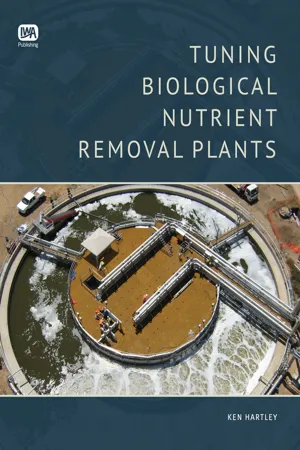
- 256 pages
- English
- PDF
- Available on iOS & Android
Tuning Biological Nutrient Removal Plants
About This Book
Tuning Biological Nutrient Removal Plants increases interest in tuning to enhance both performance and capacity, to provide insight into typical plant operating characteristics, and to stimulate operators' interest in studying the behaviour of their own plants. The book focuses on understanding of plant behavioural characteristics so that optimum performance can be achieved and maintained.
Tuning Biological Nutrient Removal Plants is carefully organized to cover: influent and effluent characteristics; process fundamentals; individual process characteristics; overall plant characteristics; the evolutionary operation approach to tuning. The approach is practical and the use of mathematics is kept to a minimum and information is supplied in graphical and tabular form.Real operating data from a wide range of plant experiences is included.
The book draws on the generosity of many Australian plant owners in permitting their plant data to be incorporated.Not all process types are covered but the tuning principles expounded are universally applicable. The capacity and performance capabilities of a plant are not fixed; both are amenable to on-going enhancement through systematic and enthusiastic effort.
The book helps to set new benchmarks in plant operation. Tuning Biological Nutrient Removal Plantsis a valuable resource forsewage treatment operations and operations support personnel, sewage process design engineers - operating authorities, consultants, contractors, operators of industrial wastewater treatment plants and sewage treatment lecturers in chemical engineering departments and other training organisations.
About the author: Ken Hartley, B.Tech, M.Eng.Sc Fellow, Institution of Engineers, Australia Member Australian Water Association Member International Water Association. Ken Hartley has 45 years' experience in the water and wastewater industry. He has worked for the South Australian water and wastewater authority, consultants GHD and the University of Queensland.Since 1998 he has been an independent consulting process engineer.
Frequently asked questions
Information
Table of contents
- Cover
- Contents
- About the Authors
- Acknowledgements
- Preface
- Chapter 1: What is tuning?
- Chapter 2: Influent and effluent characteristics
- Chapter 3: Biological nutrient removal - process fundamentals
- Chapter 4: Sludge settleability
- Chapter 5: BNR flowsheets
- Chapter 6: Reactors
- Chapter 7: Secondary clarifiers
- Chapter 8: Sludge processes
- Chapter 9: Plant characteristics
- Chapter 10: Process control
- Chapter 11: Evolutionary operation
- Appendix 1: A note on the statistics of variability
- Appendix 2: Chemicals: useful properties
- Appendix 3: Abbreviations
- References
- Index